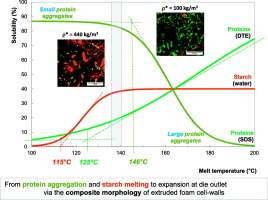Food Research International ( IF 7.0 ) Pub Date : 2018-03-16 , DOI: 10.1016/j.foodres.2018.03.027 M Kristiawan 1 , V Micard 2 , P Maladira 3 , C Alchamieh 1 , J-E Maigret 1 , A-L Réguerre 1 , M A Emin 4 , G Della Valle 1

|
Dehulled yellow pea flour (48.2% starch, 23.4% proteins, d.b.), was processed by a twin-screw extruder at various moisture contents MC (18–35% w.b.), product temperature T (115–165 °C), and specific mechanical energy SME (50–1200 kJ/kg). Structural changes of extruded pea flour were determined at different scales by measurements of density (expansion), crystallinity (X-ray diffraction), gelatinisation enthalpy (DSC), starch solubility in water and protein solubility in SDS and DTE (SE-HPLC). Foam density dropped from 820 to 85 kg/m3 with increase in SME and T (R2 ≥ 0.78). DSC and XRD results showed that starch was amorphous whatever extrusion conditions. Its solubility in water augmented up to 50%. Increasing temperature from 115 to 165 °C decreased proteins soluble in SDS from 95 to 35% (R2 = 0.83) of total proteins, whereas the proteins soluble in DTE increased from 5 to 45% (R2 = 0.75) of total proteins. These trends could be described by sigmoid models, which allowed determining onset temperatures for changes of protein solubility in the interval [125, 146 °C], whatever moisture content. The SME impact on protein solubility followed similar trends. These results suggest the creation of protein network by SS bonds, implicating larger SDS-insoluble protein aggregates, as a result of increasing T and SME, accompanied by creation of covalent bonds other than S
S ones. CSLM images suggested that extruded pea flour had a composite morphology that changed from dispersed small protein aggregates to a bi-continuous matrix of large protein aggregates and amorphous starch. This morphology would govern the expansion of pea flour by extrusion.
中文翻译:

豌豆粉挤压过程中淀粉和蛋白质的多尺度结构变化
脱壳黄豌豆粉(48.2% 淀粉,23.4% 蛋白质,db)由双螺杆挤出机在不同的水分含量MC (18–35% wb)、产品温度T (115–165 °C)和特定条件下加工。机械能SME (50–1200 kJ/kg)。通过测量密度(膨胀)、结晶度(X 射线衍射)、糊化焓 (DSC)、淀粉在水中的溶解度以及蛋白质在 SDS 和 DTE 中的溶解度 (SE-HPLC),确定了不同尺度的挤压豌豆粉的结构变化。随着SME和T的增加(R 2 ≥ 0.78),泡沫密度从820下降到85 kg/m 3 。 DSC 和 XRD 结果表明,无论挤出条件如何,淀粉都是无定形的。其在水中的溶解度增加至50%。将温度从 115 °C 升高到 165 °C 使 SDS 中可溶的蛋白质从总蛋白质的 95% 减少到 35% (R 2 = 0.83),而 DTE 中可溶的蛋白质从总蛋白质的 5% 增加到 45% (R 2 = 0.75)。这些趋势可以通过 sigmoid 模型来描述,无论水分含量如何,该模型都可以确定 [125, 146 °C] 区间内蛋白质溶解度变化的起始温度。 SME对蛋白质溶解度的影响遵循类似的趋势。这些结果表明 S 创建了蛋白质网络 S 键,意味着更大的 SDS 不溶性蛋白质聚集体,这是由于T和SME增加而导致的,同时伴随着除 S 之外的共价键的产生
S 的。 CSLM 图像表明,挤出的豌豆粉具有复合形态,从分散的小蛋白质聚集体转变为大蛋白质聚集体和无定形淀粉的双连续基质。 这种形态将控制豌豆粉通过挤压而膨胀。











































 京公网安备 11010802027423号
京公网安备 11010802027423号